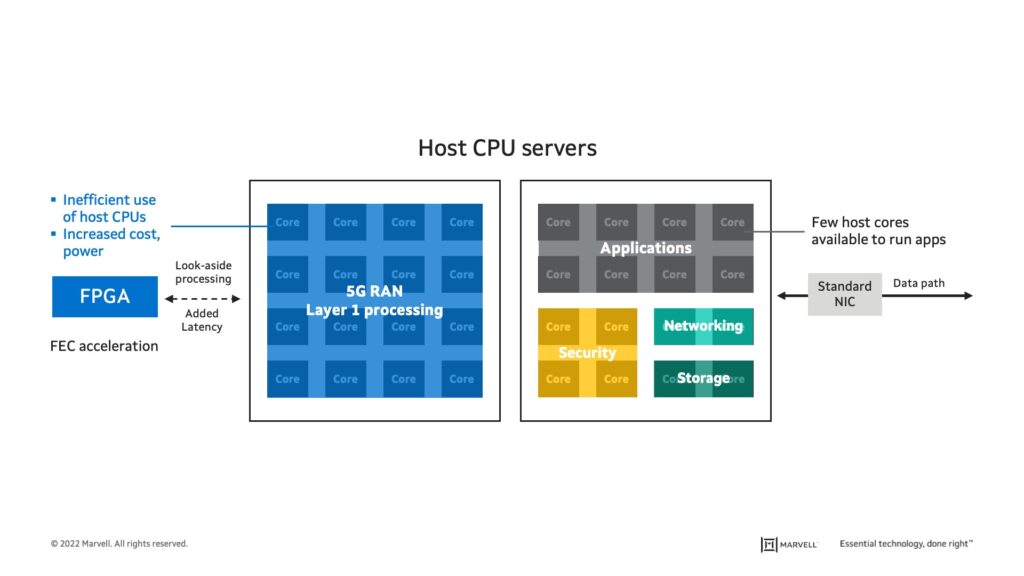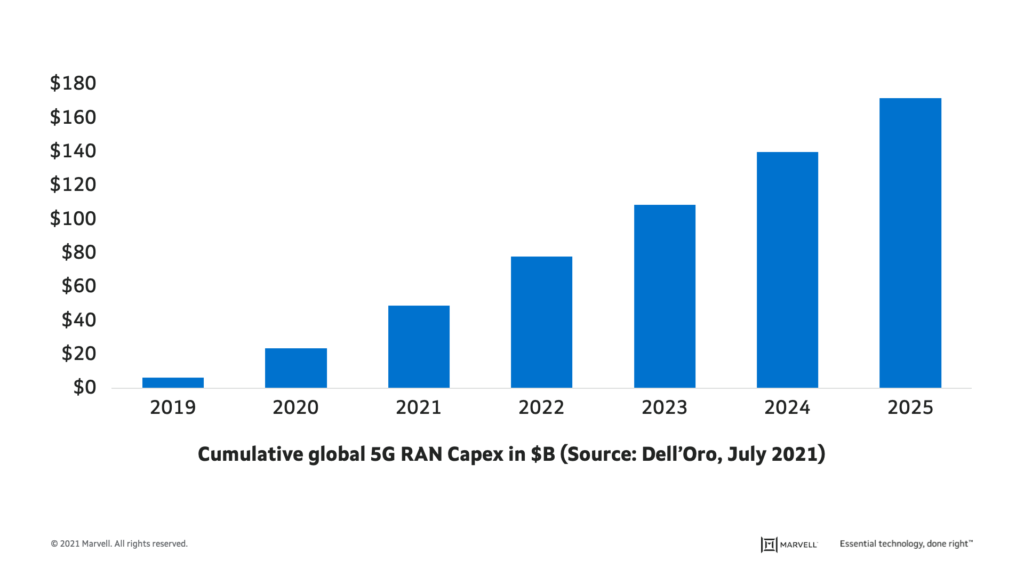Archive for the '5G' Category
-
March 23, 2023
5Gネットワークの安全性は?
By Bill Hagerstrand, Security Solutions BU, Marvell
New Challenges and Solutions in an Open, Disaggregated Cloud-Native World
Time to grab a cup of coffee, as I describe how the transition towards open, disaggregated, and virtualized networks – also known as cloud-native 5G – has created new challenges in an already-heightened 4G-5G security environment.
5G networks move, process and store an ever-increasing amount of sensitive data as a result of faster connection speeds, mission-critical nature of new enterprise, industrial and edge computing/AI applications, and the proliferation of 5G-connected IoT devices and data centers. At the same time, evolving architectures are creating new security threat vectors. The opening of the 5G network edge is driven by O-RAN standards, which disaggregates the radio units (RU), front-haul, mid-haul, and distributed units (DU). Virtualization of the 5G network further disaggregates hardware and software and introduces commodity servers with open-source software running in virtual machines (VM’s) or containers from the DU to the core network.
As a result, these factors have necessitated improvements in 5G security standards that include additional protocols and new security features. But these measures alone, are not enough to secure the 5G network in the cloud-native and quantum computing era. This blog details the growing need for cloud-optimized HSMs (Hardware Security Modules) and their many critical 5G use cases from the device to the core network.
-
February 01, 2023
ウインドリバーとマーベル、CSP向け仮想化RANソリューションの拡充で協業
By Kim Markle, Director Influencer Relations, Marvell
Wind River and Marvell have collaborated to create an open, virtualized Radio Access Network (vRAN) solution for communication service providers (CSPs) that offers cloud scalability with the features, performance, and energy efficiency of established 5G networks. The collaboration integrates two complementary, industry-leading technologies—the Marvell® OCTEON® 10 Fusion 5G baseband processor and the Wind River Studio cloud software—to provide the carrier ecosystem a deployment-ready vRAN platform built on technologies that are widely proven in 5G networks and data centers.
CSPs aim to leverage established IT infrastructure for enhanced service agility and streamlined DevOps in the cloud-native RAN. Marvell's OCTEON 10 Fusion processor supports these goals with programmability based on open-source, industry-standard interfaces and integration with leading cloud software platforms such as Wind River Studio.
To ensure open-source distribution of Wind River Studio software, OCTEON 10 Fusion software drivers are being used by StarlingX, an open development and integration project. Marvell’s drivers enable Wind River Studio software to communicate with and control the OCTEON 10 Fusion processor. This facilitates developer access to an optimized vRAN system that offers new options for CSPs and helps to expand the carrier ecosystem of RAN and data center hardware and software suppliers, as well as system integrators.
-
February 27, 2023
マーベルとVMwareがRANの最適化に向けて協力
By Peter Carson, Senior Director Solutions Marketing, Marvell and Tosin Olopade, Technical Product Line Manager, VMware and Padma Sudarsan, Director of Engineering, RAN Architecture, VMware
VMware, a pioneer in assisting communication service providers (CSPs) in transforming their networks, is partnering up with Marvell, a leading provider of data infrastructure semiconductor solutions to improve RAN performance and ROI. This collaboration provides solutions that enable CSPs to meet the demands of 5G’s increased capacity and use cases, optimizing the revenue and efficiency of each RAN site.
RAN sites worldwide are targeted for new technology deployment, where traditional, custom-made equipment is being replaced with servers adapted from data centers. This transformation to virtualized RAN and Open RAN, which replaces hardware with software, is driving the modernization of RAN sites worldwide. This allows CSPs to select servers and software based on their strategic goals, enabling them to offer unique services compared to their competitors.
However, 5G RAN workloads, particularly Layer 1 (L1), are far more complex and latency-sensitive than the applications that general purpose CPUs have been designed to address. The load on even the most robust CPUs in the case of 5G RAN virtualization can be demanding. The rapid increase in 5G network speeds, reaching multi-gigabit-per-second, and the management of software-centric RAN Distributed Units (DUs) has resulted in rising energy consumption and cooling demands. This leads to increased costs, such as higher electricity bills, and may compromise CSPs’ plans to monetize their RAN investments.
-
February 02, 2023
オープンでクラウドネイティブな5G RANへの妥協なきアプローチ
By Peter Carson, Senior Director Solutions Marketing, Marvell
The rise of fully open and optimized vRAN platforms based on globally-proven 5G layer one hardware accelerators, led by Marvell, has given Open RAN operators the industry’s first no-compromise vRAN solution. Unlike the so-called “look-aside” general-purpose alternative, the Marvell architecture is host server CPU agnostic and uniquely enables (1) RAN software programmability, based on open source, industry standard interfaces and (2) inline hardware acceleration that delivers feature, performance and power parity as compared to existing 5G networks -- absolutely critical requirements of mobile operators. Listen to what leading operators are saying about inline vRAN accelerators.
-
January 04, 2023
ソフトウェアで定義された自動車のためのソフトウェアで定義されたネットワーキング
マーベル、オートモーティブビジネスユニット、マーケティング担当バイスプレジデント、アミール・バー・ニヴ、ソナタス、および最高マーケティング責任者、ジョン・ハインライン、マーベル、オートモーティブビジネスユニット、SW担当副社長、サイモン・エーデルハウス著
ソフトウェアデファインド車両(SDV)は、自動車業界における最新かつ最も興味深いメガトレンドのひとつである。 以前のブログ で述べたように、この新しいアーキテクチャーとビジネス・モデルが成功する理由は、すべての利害関係者にメリットをもたらすからである:
- OEM(自動車メーカー)は、アフターマーケットサービスや新たなアプリケーションから新たな収入源を得るだろう。
- 車の所有者は、車の機能や特徴を簡単にアップグレードできる。
- モバイル通信事業者は、新しいアプリケーションによる車両データ消費の増加から利益を得るだろう。
ソフトウェアデファインド車両とは何か? 正式な定義はないが、この用語は、柔軟性と拡張性を可能にするため、車両設計におけるソフトウェアの使用方法の変化を反映している。 ソフトウェアデファインド車両をよりよく理解するためには、まず現在のアプローチを検証する必要がある。
今日の自動車機能を管理する組込み制御ユニット(ECU)にはソフトウェアが含まれているが、各ECUのソフトウェアは他のモジュールと互換性がなく、孤立していることが多い。 更新が必要な場合、車両の所有者はディーラーのサービスセンターに出向かなければならず、所有者は不便を強いられ、メーカーにとってはコストがかかる。
-
December 05, 2022
リーディング・ライツ賞、デネブCDSPのリーダーシップを評価
By Johnny Truong, Senior Manager, Public Relations, Marvell
 At this weeks’ Leading Lights Awards Ceremony, hosted by Light Reading, Editor-in-Chief Phil Harvey announced that the Marvell® Deneb™ Coherent Digital Signal Processor (CDSP) is the winner of the Most Innovative Service Provider Transport Solution category. This recognition is awarded to the optical systems vendor or optical components vendor providing the most innovative optical transport solution for service provider customers.
At this weeks’ Leading Lights Awards Ceremony, hosted by Light Reading, Editor-in-Chief Phil Harvey announced that the Marvell® Deneb™ Coherent Digital Signal Processor (CDSP) is the winner of the Most Innovative Service Provider Transport Solution category. This recognition is awarded to the optical systems vendor or optical components vendor providing the most innovative optical transport solution for service provider customers.Driving the industry's largest standards-based ecosystem, the Marvell Deneb CDSP enables disaggregation which is critical for carriers to lower their CAPEX and OPEX as they increase network capacity. This recognition underscores Marvell’s success in bringing leading-edge density and performance optimization advantages to carrier networks.
In its 18th year, the Leading Lights is Light Reading’s flagship awards program which recognizes top companies and executives for their outstanding achievements in next-generation communications technology, applications, services, strategies, and innovations.
Visit the Light Reading blog for a full list of categories, finalists and winners.
-
October 05, 2022
エネルギー効率の高いチップの設計
マーベル、ESGグローバルヘッド、レベッカオニールによる
今日はエネルギー効率の日である。 エネルギー、特に当社のチップに電力を供給するために必要な電力消費は、マーベルが最も重視していることである。 私たちの目標は、世代を重ねるごとに製品の消費電力を削減し、設定された機能を実現することである。
当社の製品は、クラウドや企業のデータセンター、5Gキャリアインフラ、自動車、産業用および企業用ネットワーキングにまたがるデータインフラに電力を供給する上で不可欠な役割を果たしている。 製品を設計する際には、新しい機能を提供する革新的な機能に焦点を当てると同時に、性能、容量、セキュリティを向上させ、最終的には製品使用時のエネルギー効率を改善する。
これらの技術革新は、世界のデータインフラをより効率的にし、ひいては気候変動への影響を軽減するのに役立つ。 お客様による当社製品の使用は、マーベルのスコープ3の温室効果ガス排出量に寄与している。
-
February 24, 2022
マーベル、クラウドとワイヤレス・コンピューティング・アーキテクチャのベスト・オブ・ベストを使用した、エコシステム・パートナーによる妥協のない新しいオープンRANソリューションを展示
By Peter Carson, Senior Director Solutions Marketing, Marvell
Marvell’s 5G Open RAN architecture leverages its OCTEON Fusion processor and underscores collaborations with Arm and Meta to drive adoption of no-compromise 5G Open RAN solutions
The wireless industry’s no-compromise 5G Open RAN platform will be on display at Mobile World Congress 2022. The Marvell-designed solution builds on its extensive compute collaboration with Arm and raises expectations about Open RAN capabilities for ecosystem initiatives like the Meta Connectivity Evenstar program, which is aimed at expanding the global adoption of Open RAN. Last year at MWC, Marvell announced it had joined the Evenstar program [read more]. This year, Marvell’s new 5G Open RAN Accelerator will be on display at the Arm booth at MWC 2022. The OCTEON Fusion processor, which integrates 5G in-line acceleration and Arm Neoverse CPUs, is the foundation for Marvell’s Open RAN DU reference design.
5G is going mainstream with the rapid rollout of next generation networks by every major operator worldwide. The ability of 5G to reliably provide high bandwidth and extremely low latency connectivity is powering applications like metaverse, autonomous driving, industrial IoT, private networks, and many more. 5G is a massive undertaking that is set to transform entire industries and serve the world’s diverse connectivity needs for years to come. But the wireless networks at the center of this revolution are, themselves, undergoing a major transformation – not just in feeds and speeds, but in architecture. More specifically, significant portions of the 5G radio access network (RAN) are moving into the cloud.
-
February 24, 2022
妥協のない5GオープンRAN: コンピュート・アーキテクチャ
By Peter Carson, Senior Director Solutions Marketing, Marvell
はじめに
5G networks are evolving to a cloud-native architecture with Open RAN at the center. This explainer series is aimed at de-mystifying the challenges and complexity in scaling these emerging open and virtualized radio access networks. Let’s start with the compute architecture.
The Problem
Open RAN systems based on legacy compute architectures utilize an excessively high number of CPU cores and energy to support 5G Layer 1 (L1) and other data-centric processing, like security, networking and storage virtualization. As illustrated in the diagram below, this leaves very few host compute resources available for the tasks the server was originally designed to support. These systems typically offload a small subset of 5G L1 functions, such as forward error correction (FEC), from the host to an external FPGA-based accelerator but execute the processing offline. This kind of look-aside (offline) processing of time-critical L1 functions outside the data path adds latency that degrades system performance.

Image: Limitations of Open RAN systems based on general purpose processors
-
December 07, 2021
5Gアクセス・ネットワークのための光技術
By Matt Bolig, Director, Product Marketing, Networking Interconnect, Marvell
There’s been a lot written about 5G wireless networks in recent years. It’s easy to see why; 5G technology supports game-changing applications like autonomous driving and smart city infrastructure. Infrastructure investment in bringing this new reality to fruition will take many years and 100’s of billions of dollars globally, as figure 1 below illustrates.

図 1:Cumulative Global 5G RAN Capex in $B (source: Dell’Oro, July 2021)
When considering where capital is invested in 5G, one underappreciated aspect is just how much wired infrastructure is required to move massive amounts of data through these wireless networks.
-
October 03, 2021
次世代イーサネットで5Gネットワークのパフォーマンスを引き出す
By Alik Fishman, Director of Product Management, Marvell
Blink your eyes. That’s how fast data will travel from your future 5G-enabled device, over the network to a server and back. Like Formula 1 racing cars needing special tracks for optimal performance, 5G requires agile networking transport infrastructure to unleash its full potential. The 5G radio access network (RAN) requires not only base stations with higher throughputs and soaring speeds but also an advanced transport network, capable of securely delivering fast response times to mobile end points, whatever those might be: phones, cars or IoT devices. Radio site densification and Massive Machine-type Communication (mMTC) technology are rapidly scaling the mobile network to support billions of end devices1, amplifying the key role of network transport to enable instant and reliable connectivity.
With Ethernet being adopted as the most efficient transport technology, carrier routers and switches are tasked to support a variety of use cases over shared infrastructure, driving the growth in Ethernet gear installations. In traditional cellular networks, baseband and radio resources were co-located and dedicated at each cell site. This created significant challenges to support growth and shifts in traffic patterns with available capacity. With the emergence of more flexible centralized architectures such as C-RAN, baseband processing resources are pooled in base station hubs called central units (CUs) and distributed units (DUs) and dynamically shared with remote radio units (RUs). This creates even larger concentrations of traffic to be moved to and from these hubs over the network transport. -
April 01, 2021
マーベル、5Gの真の可能性を引き出すO-RANを実現
マーベル、PR チーム
At the most recent FierceWireless 5G Blitz Week, some of the world’s leading 5G innovators met via webinar to discuss the potential of O-RAN and challenges of the ongoing 5G rollout. In a keynote, EVP and General Manager of Marvell’s Processors Business Group Raj Singh explored the accelerating shift to O-RAN, which is an emerging open-source architecture for Radio Access Networks that enables customers to create better 5G applications by mixing and matching RAN technology from different vendors.
O-RAN architectures are compelling because they increase competition among vendors, reduce costs, and offer customers greater flexibility to combine RAN elements according to their application’s specific use cases. However, in addition to their obvious benefits, O-RAN solutions also raise operator concerns including potential challenges with integration, legacy support, interoperability and security – issues that Marvell and other companies in the Open RAN Policy Coalition are addressing through shared standards, proven solutions and innovative approaches.
最新の記事
- HashiCorp and Marvell: Teaming Up for Multi-Cloud Security Management
- Cryptomathic and Marvell: Enhancing Crypto Agility for the Cloud
- The Big, Hidden Problem with Encryption and How to Solve It
- Self-Destructing Encryption Keys and Static and Dynamic Entropy in One Chip
- Dual Use IP: Shortening Government Development Cycles from Two Years to Six Months

